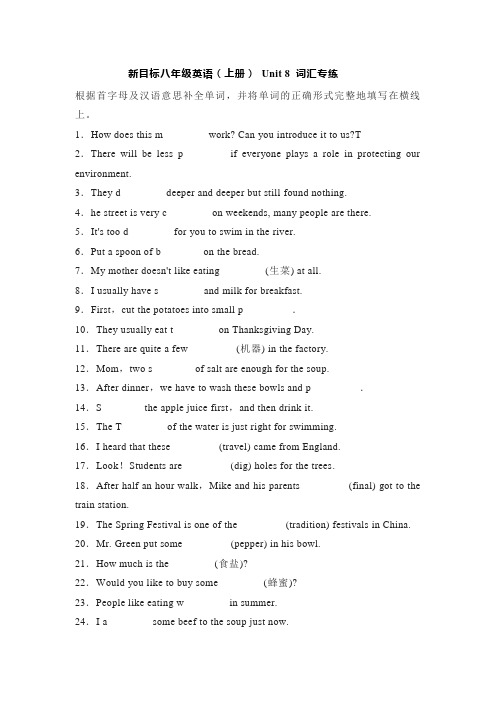新目标八年级下Unit 8 教材优化全析全练
- 格式:doc
- 大小:92.00 KB
- 文档页数:7

2020年春人教新目标英语八年级下册Unit8 Have_you_read_Treasure_Island_yet?知识点一、重点短语:1.听说hear of2. 像……一样be like3. 出去go out4. 充满full of5. 做完某事finish doing sth6. 关于be about7. 长大grow up 8. 把…放下put …down9. 快点hurry up (in a hurry匆忙地) 10. 造船make a boat11.带回bring back 12.放弃give up13. 等待wait for 14. 砍倒cut down15. 为了食物而杀…kill…for food16. 还有谁who else17.看见某人正在做某事see sb. doing sth. 18. 向(朝)……跑去run towards19. 给某人取名为……name sb.…20. 迫不及待做某事can’t wait to do sth.21.过去常常used to22. 争吵fight over23. 回家return home 24. 在收音机上on the radio25. 使某人做某事make sb. do sth 26. 逐渐认识到come to realize27. 自从……以来ever since 28. ……的家the home of29. 例如such as 30. 属于belong to31. 对某人友好be kind to sb 32. 互相信任trust one another33. 使某人想起……remind sb. that…34. 去过…have been to35. 研究do research on 36. 希望做某事hope to do sth37. 介绍……给……introduce …to38. 失去生命lose one’s life39. 去出国/ 出国学习go / study abroad 40. 数以百万计的;无数的millions of二、重点句子:讲一讲1现在完成时(section A)1.2. 过去分词与过去式的变化相同。


中考英语二轮复习第一部分教材知识梳理:人教八年级(下) Units 7—8单元重点回顾续表单元重难点突破对于物体长、宽、高、深度、面积的表达 (八下Unit 7 P49)【举例透析】20米长 20 meters long/in length 10米宽 10 meters wide15米深 15 meters deep/in depth 150平方米 150 square meters(对于物体长、宽、高、深度、面积的表达:数词+单位名词+adj.或in +n.) This is a 160meter high tower.这是一座160米高的塔。
(也可用“数词单位名词形容词”,常用作定语。
)1.珠穆朗玛峰高8 844.43米。
Qomolangma is 8,844.43 __meters__ __high__. 2.我在动物园看到一条长2米的蛇。
I saw a __two -meter -long__ snake in the zoo.population (八下Unit 7 P50)【举例透析】①China has the biggest population in the world.中国有世界上最多的人口。
China has a large/big population but Singapore has a small population.中国人口多但新加坡人口少。
(population作名词,意为人口;修饰人口多少用:large/big或small)②—How large/What is the population of China? 中国的人口有多少?—It has a population of over 1.3 billion.它有超过13亿的人口。
(询问人口多少时用:How large…?/What's…?)③The world's population is increasing faster and faster.全世界的人口增长越来越快。


新目标八年级英语(上册)Unit 8 词汇专练根据首字母及汉语意思补全单词,并将单词的正确形式完整地填写在横线上。
1.How does this m________ work? Can you introduce it to us?T2.There will be less p________ if everyone plays a role in protecting our environment.3.They d________ deeper and deeper but still found nothing.4.he street is very c________ on weekends, many people are there.5.It's too d________ for you to swim in the river.6.Put a spoon of b________on the bread.7.My mother doesn't like eating ________(生菜) at all.8.I usually have s________ and milk for breakfast.9.First,cut the potatoes into small p________ .10.They usually eat t________ on Thanksgiving Day.11.There are quite a few ________ (机器) in the factory.12.Mom,two s________of salt are enough for the soup.13.After dinner,we have to wash these bowls and p________ .14.S________the apple juice first,and then drink it.15.The T________ of the water is just right for swimming.16.I heard that these ________ (travel) came from England.17.Look!Students are ________ (dig) holes for the trees.18.After half an hour walk,Mike and his parents ________ (final) got to the train station.19.The Spring Festival is one of the ________ (tradition) festivals in China. 20.Mr. Green put some ________ (pepper) in his bowl.21.How much is the ________(食盐)?22.Would you like to buy some ________(蜂蜜)?23.People like eating w________ in summer.24.I a________ some beef to the soup just now.25.Does your brother like y________very much?26.Jane s________ the bottle before she drink the orange juice. 27.F________, we arrived at the train station at 4:30 p.m. 28.Go to the store and get two s________ this afternoon. 29.Look!Bill is p________ water into the pot.30.Can you help me to p________ two potatoes,Jim? 31.We all know a________ comes after summer.32.The highest t________ is 30℃ today.33.It's difficult for us to decide how to c________ her birthday. 34.Please give me two large p________ of dumplings. 35.Next,m________ together all the vegetables.36.Be careful when you take the cake out of the o________. 37.The small restaurant s________ delicious rice noodles. 38.Mike is very interested in t________ Chinese food. 39.The t________ is so tired that he doesn't want to walk. 40.Mr.Wang hopes to visit E________ with his family one day. 41.Eating too much s________ is bad for your teeth. 42.What t________ food do you have on Mid-Autumn Day? 43.There is a h________ in the door.44.Don't p________ waste water into the river.It will pollute it. 45.Please put the bread on the p________,not in the bowl. 46. ________ (final) we got to the top of the mountain. 47.Pass me three ________ (piece) of bread.48.How much ________ (butter) is there on the bread? 49.Make sure all the ________ (travel) know the instructions. 50.I like ________ (sandwich).They are very delicious. 51.There are two small h________ on the sweater.52.Some farmers are growing c________ on the farm. 53.Lisa was hungry and had some bread and c________.54.They want to buy some new m_______ next year. 55.How about d________ in front of the hill?参考答案1.machine2.pollution3.dug4.crowded5.dangerous6.butter7.lettuce8.sandwiches9.pieces 10.turkey11.machines12.spoons13.plates14.Shake15.temperature16.travelers17.digging18.finally19.traditional20.pepper21.salt22.honey23.watermelons24.added25.yogurt26.shook27.Finally28.spoons29.pouring30.peel31.autumn32.temperature33.celebrate34.plates35.mix36.oven37.serves38.traditional39.traveler/traveller40.England41.sugar42.traditional43.hole44.pour45.plate46.Finally47.pieces48.butter49.travelers50.sandwiches 51.holes52.corn53.cheese54.machines55.digging。

新目标八年级下英语(Unit 8)练习试题一.单项选择。
( ) 1. I guess there are ________ in the kitchen.A. spiderB. monkeyC. mouseD. mice( ) 2. We chose _____ a nice card by ourselves for our teacher on Teachers' Day after we had a discussion.A. makingB. doingC. to makeD. to do( ) 3. I think he must be able to make ______this term, because he works hard at all his subjects.A. many progressB. a progressC. much progressD. some progresses( ) 4. --Why do you think he is the _______ student in your class?--Because he alway likes to ask questions and his grades are really good.A. modestB. most modestC. more modestD. modestest( ) 5. --How long did you stay at home last Sunday?--______________________.A. Nearly a whole dayB. For nearly a weekC. At about three o'clockD. Before supper( ) 6. --May I know your age, Mrs Smith?--Sorry. It's my _____________ secret.A. seriousB. personalC. normalD. lucky( ) 7. --Who was the ________ of the English speech?--Han Mei was. She got the first prize.A. hostB. winnerC. listenerD. teacher ( ) 8. I sent you a letter a week ago. Have you_______ it yet?A. givenB. broughtC. receivedD. laicked( ) 9. --What did your teacher suggest ___________?--Reading more books.A. to doB. doingC. doD. did( )10. 2013 will be the Year of the________A. RabbitB. TigerC. SheepD. Snake( )11. --One of the __ is playing the violin in the park.--He is my brother. He likes music very much.A. boyB. childC. kidD. children( )12. --Your coat is so nice on you.--Thank you. It _______ me one hundred yuan yesterday.A. spentB. tookC. costD. paid( )13. --Did you buy any hamburgers for your brother?--No. I bought some bread_______ hamburgers for him.A. insteadB. instead ofC. butD. not but( )14. There are many sports stars in China________ Yao Ming.A. besidesB. exceptC. butD. include( )15. --Why don't you like to play with him?--Because he is a _______ boy. His parents don't let him play.A. shyB. specialC. politeD. friendly二.完形填空。
【人教版】新目标八年级英语上册:Unit 8 单元说课稿一. 教材分析人教版新目标八年级英语上册Unit 8主要讲述了关于野生动物的保护以及人们与动物之间的互动。
本单元通过引入野生动物的话题,引导学生关注动物保护的重要性,提高他们的环保意识。
教材中包含了丰富的插图、阅读材料和实践活动,使学生在学习语言知识的同时,能够深入了解动物保护的相关知识,培养他们的综合语言运用能力。
二. 学情分析八年级的学生已经具备了一定的英语基础,能够进行简单的英语交流。
但他们在语言运用方面还存在一定的问题,如词汇量有限、语法知识掌握不扎实等。
此外,学生对动物保护这个话题可能比较陌生,因此需要在教学中给予适当的引导。
三. 说教学目标1.知识目标:学生能够掌握本单元的重点词汇、固定搭配和语法知识;2.能力目标:学生能够运用所学知识进行阅读、写作和口语交流;3.情感目标:学生能够增强环保意识,关注野生动物的保护。
四. 说教学重难点1.重点:本单元的重点词汇、固定搭配和语法知识;2.难点:如何运用所学知识进行阅读理解、写作和口语交流。
五. 说教学方法与手段1.任务型教学法:通过设置各种任务,引导学生主动参与课堂活动,提高他们的语言运用能力;2.情境教学法:创设真实的语境,让学生在实践中学习和应用英语;3.合作学习法:鼓励学生分组讨论、合作完成任务,培养他们的团队协作能力;4.多媒体教学手段:利用课件、视频等资源,丰富教学内容,激发学生的学习兴趣。
六. 说教学过程1.导入:通过展示野生动物的图片,引导学生关注动物保护的话题;2.呈现:介绍本节课的主要内容,让学生了解本节课的学习目标;3.practice:通过各种练习活动,让学生巩固所学知识;4.production:设置实际情境,让学生运用所学知识进行口语交流和写作;5.总结:对本节课的内容进行归纳总结,强调动物保护的重要性。
七. 说板书设计板书设计应突出本节课的主要知识点,包括词汇、固定搭配和语法结构。
人教版八年级英语教材分析一.本套教材编写的指导思想、理念、特点教材强调课程从学生的学习兴趣,生活经验和认识水平出发,倡导体验,实践,参与,合作与交流的学习方式,发展学生的综合语言运用能力,使语言学习的过程成为学生形成积极的情感态度,主动思维和大胆实践,提高跨文化意识,本教材与旧教材的不同在于,以往课堂所传授的语言知识主要来源于教师和课本,教师把备好的语言知识单方面传授给学生,然后组织学生对所学知识进行控制性练习,一切主动权操纵在教师手中,而Go for it!教材则要求采用互动的课堂模式,提倡开放的学习方式,鼓励学生创造性地运用语言。
“互动”,“开放”和“创造”营造了平等,民主,宽松的课堂氛围,在“互动”,“开放”“创造”中,学生获得了相当大的主动权。
第二点不同的是,传统的教学情境强调教材的单一因素,而此教材强调教师,学生,内容,环境四因素的整合,四因素持续交互,呈动态发展。
再者,过去的传统课堂教学是学生各个孤立的学习,而此套教材要求学生在独立思考的基础上进行合作学习;旧教材以学生接受式学习为主,新教材则要求以探究式学习为主;旧教材是以教师传授语言知识为主线的精讲知识,多练句型式的学习,新教材则要求学生主动参与为主的任务驱动型学习,旧教材是以单一课本为主,新教材则教学内容灵活开放,提倡教师结合学生实际,灵活处理,同时注意多渠道开发教学资源;旧教材只涉及英语语言本身,而新教材要求涉及文化,情感,态度和跨学科内容;旧教材过分注重学生的学科考试成绩,而新教材更注重学生的素质培养;旧教材只注重考试的结果,而新教材要求重过程,讲策略等等,这些差异使得教学由统一性,确定性变成多样性,不确定性,因此为教学带来了更大的难度,但同时又为教师的创造性提供了更大的空间,特别是“任务型”教学使教师面临巨大的挑战,因此今天的教师不应该是一桶水,而应该是一条流动的小溪。
此教材无论从语言知识,语言技能方面,还是从文化意识,情感,态度和学习策略等方面,都体现和达到了相当理想的地步。
【人教版】新目标八年级英语上册:Unit8单元说课稿一. 教材分析新目标八年级英语上册Unit8主要围绕着“购物”这一主题展开,通过学习本单元,学生能够掌握有关购物的词汇和表达方式,同时提高在购物场景中的交际能力。
教材以任务型教学法为主线,通过听、说、读、写等多种教学活动,使学生在真实的情境中感受、体验和运用英语。
二. 学情分析根据我对学生的了解,他们已经掌握了基本的英语语法和词汇,但对于购物场景的表达和交际还存在一定的困难。
此外,学生在听、说、读、写等方面的能力参差不齐,因此在教学过程中需要关注到这一点,尽量让每个学生都能参与到课堂活动中来。
三. 说教学目标根据课程标准和新目标教材的要求,本节课的教学目标如下:1.知识目标:学生能够掌握与购物相关的词汇和表达方式,如“购物”、“挑选”、“付款”等。
2.能力目标:学生在购物场景中能够运用所学知识进行简单的听、说、读、写活动。
3.情感目标:通过本节课的学习,学生能够提高对英语学习的兴趣,增强自信心。
四. 说教学重难点1.重点:购物场景下的基本词汇和表达方式。
2.难点:在购物场景中运用英语进行交际。
五. 说教学方法与手段本节课采用任务型教学法,结合多媒体辅助教学,通过听、说、读、写等多种教学活动,使学生在真实的情境中感受、体验和运用英语。
在教学过程中,我会关注学生的个体差异,尽量让每个学生都能参与到课堂活动中来。
六. 说教学过程1.导入:以一首关于购物的英文歌曲《Shopping》导入,激发学生的学习兴趣。
2.新课呈现:通过展示一幅购物场景的图片,引出本节课的主题,并呈现相关词汇和表达方式。
3.课堂活动:a.分组进行角色扮演,模拟购物场景,练习交际用语。
b.完成一个购物小任务,如“购买一件衣服”,要求学生用英语进行交流。
c.学生展示自己的购物心得,分享购物经验。
4.巩固练习:通过完成一个购物问卷,检验学生对本节课知识的掌握程度。
5.总结:对本节课的内容进行归纳总结,提醒学生关注购物场景下的交际技巧。
Unit 8 Have you read Treasure Island yet ? 知识梳理
教学目标
Section A 第一课时(1a~2d)目标要求
检查预习
教学过程
随堂练习
布置作业:教师引导学生课后完成本课时对应练习,并预习下一课时内容。
反思
Section A 第二课时(3a~4c)目的要求
检查预习
教学过程
随堂练习
布置作业:教师引导学生课后完成本课时对应练习,并预习下一课时内容。
Section B第4课时(2a~2e)目的要求
检查预习
教学过程
随堂练
布置作业:教师引导学生课后完成本课时对应练习,并预习下一课时内容。
Section B第5课时(3a~3b)目的要求
检查预习
教学过程
随堂练习
布置作业:教师引导学生课后完成本课时对应练习,并预习下一课时内容。
[教材优化全析]unit 8 初二下Section A1.What do you think of these gifts?Write each gift under one or more of the words in the chart.Add other gifts to each column.你认为这些礼物怎么样?把每一样礼物填写在下面的表格里,然后在每一项的后面再填上其他的礼物。
What do you think of...? 你认为……怎么样?例如:What do you think of Chinese food?你认为中国食物怎么样?What do you think of the novel written by Jiu Dan?你认为九丹写的这篇小说怎么样?2.What should I get my mom for her birthday?我应该送给妈妈什么作为她的生日礼物?How about a scarf?送条围巾怎么样?No,that’s too boring.不,这太没意思。
3.Listen and number the comments in the order you hear them.听录音并按你听到的顺序给下面的评论标上序号。
4.Listen.In each conversation about gifts,who is the person shopping for?Put a check (√)in the correct column.听力。
在每一段关于礼物的对话中,这个人是在为谁买东西?在每一个正确的选项上打√。
5.not special enough 不够特别not creative enough 不够有创造力enough“足够的”,修饰形容词或副词,要放在它所修饰的词后面。
例如:He tried to tell the children some interesting stories,but none of them is interesting enough.他尽量给孩子们讲些有趣的故事,但这里面没有一个是足够有趣的。
6.Think of a friend or a family member who is having a birthday soon. Then discuss with your partner what to get this person.想出一位就要过生日的朋友或家庭成员,然后和你的搭档谈谈要给这个人买什么。
7.Grammar Focus 语法聚焦提出建议:(1)What should I get my sister?我该给我的妹妹买什么?(2)Why don’t you get a camera?你为什么不买一架照相机呢?(3)How about some tennis balls?买一些网球怎么样?(4)What about a watch?买一块手表怎么样?(5)Why don’t you buy a scarf?你为什么不买一条围巾呢?给出讨论:(1)That’s too expensive.那太贵了。
(2)They’re too cheap.它们太便宜了。
(3)That’s too personal.那太个人化了。
(4)That’s not interesting enough.那不够有趣。
8.Student A,look at this page. Student B,turn to Page 87. Exchange information and fill in the chart.学生A,看这一页。
学生B,翻到87页。
交换信息填写下列表格。
9.What’s the best gift Joe has ever received?乔曾收到的最好的礼物是什么?10.on his sixth birthday 在他6岁的生日时on one’s+序数词birthday 在某人……岁生日时。
例如:全析提示What do you think of...? =How do you like...?主要用来询问对某物的评价或看法。
全析提示How about/Whatabout+n./v.-ing...?……怎么样?这句话表示对上述提议的评价。
全析提示shop vi.购物,买东西要点点拨enough修饰名词时放在它所修饰的词前面和后面均可。
enough room=room enough足够的空间全析提示think of 想出,想起...is having在这个句子中用现在进行时表示将来时。
要点点拨我们常用(1)~(5)这组句型来提出建议。
思维拓展That’s...They’re...这是给出评论的一组句子,你可以用它们来评价提出的建议。
全析提示exchange information交换信息exchange vt. 交换exchange students交换生思维拓展在英语中“在哪一天”用on。
on my tenth birthday 在我10岁生日时11.What a lucky guy!多幸运的一个小伙子!这是一个感叹句,英语中感叹句有两种结构,一种以what 开头,其基本结构是:(1)What+a(an)+形容词+单数可数名词+主语+谓语+其他!例如:What a boring story it is!多冗长的一个故事啊!What a wonderful football match we saw last night!昨晚我们看的那场足球赛多精彩啊!(2)What+形容词+复数名词或不可数名词+主语+谓语+其他!例如:What clever students they are!他们是多么聪明的学生啊!What kind people they are!他们是多么善良啊!另一种是以how开头,其基本结构是:How+形容词或副词+主语+谓语+其他!例如:How warm it is in winter in Hong Kong!香港的冬天好暖和啊!How fast Mary speaks!玛丽讲话好快啊!12.Tell the class what you are going to do for someone’s birthday. The class tries to guess the person.告诉同学们你打算为一个人的生日做什么。
同学们试着猜一猜这个人是谁。
13.I’m going to make a special meal.我打算做一顿特殊的饭菜。
make a special meal做一顿特殊的饭菜。
例如:We made a special meal for my grandma’s eightieth birthday last Sunday.上个星期天我们特地为我奶奶的八十岁生日准备了一顿丰盛的饭菜。
Section B1.Which of these animals would be good pets? Which would be bad pets? Write them in the diagram and compare your choices with your classmates.下面哪些动物将是好宠物?哪些将是不好的宠物?把它们写在表格中并和你的同学比较你的选择。
2.Make a list of the pets you have.What’s the most popular pet?What’s the most unusual pet?Tell the class.列一张你所拥有的宠物的名单。
什么是最受欢迎的宠物?什么是最不同寻常的宠物?告诉同学们。
Cats are the most popular pets.猫是最受欢迎的宠物。
Parrots are the most unusual pets.鹦鹉是最不同寻常的宠物。
3.Listen and number the pets in the order you hear them.Write the numbers on the lines in the chart.听录音并按你听到的顺序给这些宠物标上序号。
把序号写在表格中的横线上。
4.What do you think is the best pet for these people?Fill in the chart.Then talk about your choices.你认为对这些人们来说,最佳的宠物是什么?填写下面表格。
然后谈论一下你的选择。
5.I think a dog is a good pet for a 6-year-old child.我认为狗对一个6岁的孩子来说是一种好的宠物。
a 6-year-old child一个6岁的孩子an 80-year-old grandmother 一个80岁的老奶奶a 16-year-old boy一个16岁的男孩6.Dogs are too difficult to take care of.狗很难照料。
(1)too...to...太……以至于不能……例如:The box is too heavy to carry.这个箱子太重了,以至于搬不动。
The snake is too boring to keep.养蛇太无聊了,以至于不愿养。
(2)too...(for sb.)to do sth....太……以至于某人不能……例如:on Sunday on June 1ston a windy morning全析提示在口语中,表示强烈的语气时,常常省略感叹句中的主、谓语部分,有时只用一个词或短语,有时还省略感叹句中的副词和形容词。
例如:What delicious food!多么可口的食品!How tall!真高!How they worked!他们干得多起劲啊!Wonderful!妙极了!try to do sth. 试图做某事,努力做某事try not to do sth.试着不要干某事要点点拨我们学过的能够表示将来的时态有三种:(1)be going to+动词原形(2)will/shall+动词原形(3)be+v.-ing全析提示good pets 好宠物bad pets 坏宠物compare...with...把……和……对比,……和……比较choice n.选择choose v.选择全析提示popular 和unusual的比较级和最高级都是加more和most。
popularmore popularmost popularunusualmore unusualmost unusual全析提示talk about 谈论全析提示for对于……I think...的否定句式为:I don’t think...全析提示This kind of books is too difficult for the teens to read.这类书对青少年来说太难读懂了。